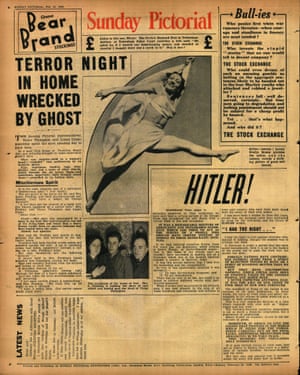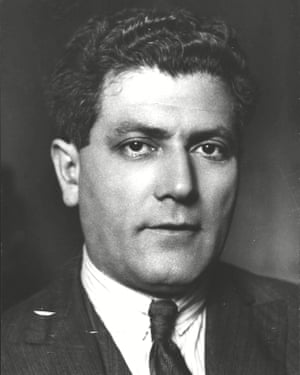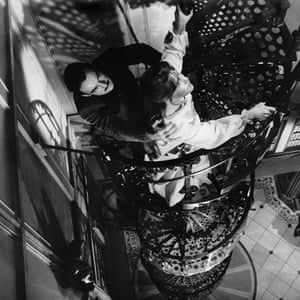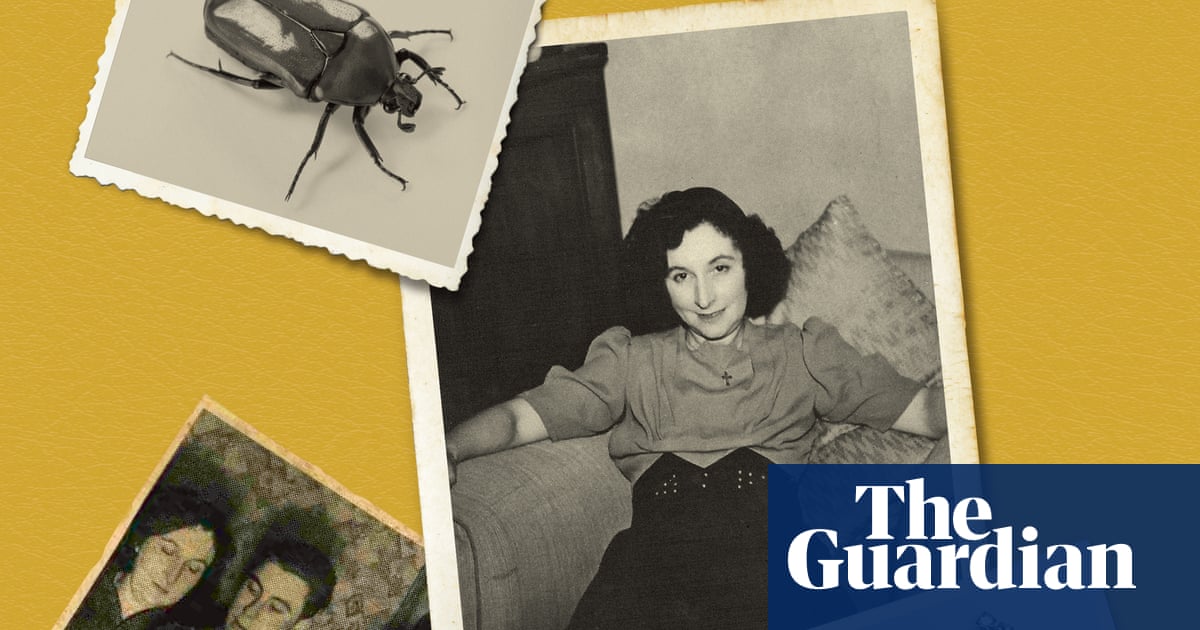On 20 February 1938, the Sunday Pictorialcarried a report of a haunting in Croydon. A 34-year-old housewife had called to tell them about strange events at the home she shared with her husband Les, her son Don and their lodger, George Saunders. “Come to my house,” Alma Fielding implored the Pictorial’s news desk. “There are things going on here I cannot explain.”
The Sunday Pic, as it was known to its readers, dispatched two reporters to Croydon. As Alma opened the front door to them, they saw an egg fly down the corridor to land at their feet. As she led them to the kitchen, a pink china dog rattled to the floor and a sharp-bladed tin opener cut through the air at head height. In the front parlour, a teacup and saucer lifted out of Alma’s hands as she sat with her guests, the saucer spinning and splintering with a “ping!” as if shot in midair. She screamed as a second saucer exploded in her fingers and sliced into her thumb. While the wound was being bandaged, the reporters heard a crash in the kitchen: a wine glass had apparently escaped a locked cabinet and shattered on the floor. They saw an egg whirl in through the living room door to crack against the sideboard. A giant chunk of coal rose from the grate, sailed across the room, inches from the head of one of the reporters, and smacked into the wall.
The Fieldings’ house seemed to be under siege from itself. Les, Don and George were at home but, as far as the Pictorial men could tell, none of them was responsible for the phenomena: the objects were propelled by an unseen force.
The Pictorial published its piece the next morning, under the slogan: “This is the most curious front page story we have ever printed.” In an ordinary terrace in Croydon, it declared, “some malevolent, ghostly force is working miracles. Poltergeist … That’s what the scientists call it. The Spiritualists? They say it’s all caused by a mischievous earth-bound spirit.”
•••
In January 2017 I visited the Society for Psychical Research archive in Cambridge to look up some references to the ghost hunter Nandor Fodor, who had investigated the case of Alma Fielding and the Croydon poltergeist. I didn’t expect to find anything directly relevant: Fodor had been working for a rival organisation, the International Institute for Psychical Research, whose papers were said to have been destroyed by German bombs. But when the documents were delivered to the university library’s manuscripts room, I discovered that they were Fodor’s original records. The SPR must have acquired the International Institute’s archive when the smaller organisation was disbanded in the 1940s.

To my delight, one of the files turned out to be Fodor’s dossier on Alma, mistakenly catalogued as a holding on “Mr” Fielding. The manila folder contained transcripts of Fodor’s interviews and seances with Alma, lab reports, X-rays, copies of her contracts, scribbled notes, sketches, photographs of the damage wrought by the poltergeist in Alma’s house and on her body. From Alma’s story Fodor had deduced, to the horror of his colleagues, that repressed memories could generate terrifying physical events.
A Jewish-Hungarian émigré, Fodor had thrown himself into the 30s supernatural scene. He joined the Ghost Club and the London Spiritualist Alliance, befriended members of the Faery Investigation Society, contributed articles to the spiritualist weekly Light. Spiritualism was big business in Britain. The faith offered “something tremendous”, said Arthur Conan Doyle, “a breaking down of the walls between two worlds … a call of hope and of guidance to the human race at the time of its deepest affliction”. After the terrible losses of the first world war and the influenza pandemic of 1918, thousands of spiritualist seance circles had been established by the bereaved. In effect, a seance was a voluntary haunting, a summoning of ghosts, at which the dead would speak through mediums, rap on tables, sometimes even let themselves be touched, smelt or seen. These forms of contact seemed hardly more outlandish than methods that had become commonplace since the war. Soon, predicted Fodor, “the mechanism of psychic communication will be understood and used with the same facility as the wireless and the telephone”.
Scores of seances and private consultations were advertised in the spiritualist press, along with lectures at psychical research societies, books and pamphlets on the occult, displays of clairvoyance and levitation. Some spiritualists believed that there was so much supernormal activity because the dead were straining to come closer. “The boundary between the two states – the known and the unknown – is still substantial,” wrote the renowned physicist and radio pioneer Sir Oliver Lodge, who had lost a son in the war, “but it is wearing thin in places, and like excavators engaged in boring a tunnel from opposite ends, amid the roar of water and other noises, we are beginning to hear now and again the strokes of the pickaxes of our comrades on the other side.”
But Fodor, having read the work of Sigmund Freud, was becoming sceptical about spiritualism. He believed that supernormal phenomena might be caused not by the shades of the dead but by the unconscious minds of the living – and he sensed that Alma Fielding was the perfect subject on whom to test his theories.
When Fodor took Alma to the International Institute in Kensington, he and his colleagues saw a diamanté brooch materialise from thin air, then an ancient oil lamp, a white mouse, a scarab beetle, a Javanese sparrow. She seemed able to astrally project herself from Croydon to Kensington and back again, and to open herself to spirit possession. To assess her powers, Fodor used all the modern methods at his disposal: voice recorders, telephones, cameras, X-rays, chemical analysis, hypnosis and word-association tests. He gathered witness statements and transcribed Alma’s dreams, sent investigators to track her movements. He laid traps. If Alma’s phenomena were tricks, he wanted to know how she was pulling them off. If not, he needed to understand the psychic mechanisms by which they were generated.
“There is a door which leads from the mind we know to the mind we do not know,” he told the Daily Mirror in March 1938. “Now and again that door is opened. Strange things happen. There are manifestations, queer phenomena, transfigurations.” As the door to the unconscious swung open, Fodor reasoned, a suppressed feeling might escape its human host in material form. He speculated that mediums discharged electromagnetic rays from their fingers and toes, or extruded invisible, semi-metallic psychic rods, or ectoplasmic threads like cobwebs. “There are, it is plain, strange forces about us of which we know practically nothing,” he said, “just as once we knew nothing of electricity.”

Fodor noticed that Alma often seemed detached from herself when a weird event took place, and he wondered if at such moments her buried life surged to the surface and broke out. He was intrigued by the phenomenon of mental dissociation, which had been observed both in mediums and in victims of shellshock. The subject fascinated novelists, too. Agatha Christie featured characters with split consciousness or dual personality in her short-story collection The Hound of Death. The protagonist of Patrick Hamilton’s novel Hangover Square is helplessly besotted with a woman who spurns him, and at a “click!” in his head (“or would the word ‘snap’ or ‘crack’ describe it better?” he wonders), his yearning, humiliated self is replaced with a numb, implacable avenger. Fodor wondered whether Alma’s psyche had fractured under pressure of a forbidden emotion. Perhaps she underwent spells of amnesia in which she unconsciously carried out supernatural tricks. Or perhaps her estranged alter ego was escaping her body altogether, snapping and cracking itself into being as an external, physical force. Ping!
In March, Fodor arranged a day trip to Bognor Regis with Alma and four members of the Institute. Alma, in skittish spirits, agreed to see if her poltergeist could spirit a ring from the local branch of Woolworths. At the jewellery counter in the Bognor Woolies, Fodor and his party watched Alma select a ring with two stones on a curved bridge, examine it, then return it to the assistant; it was the nicest ring there, Alma said, but she did not want to buy it today. The shop girl eyed them suspiciously as they moved away. “It looked fishy to her,” wrote Fodor. “She followed us. We began to feel uncomfortable.” As the group turned into a road near the shop, Alma said that she heard a rattle in the box that she was carrying. Fodor took the box from her, opened it, and found the ring she had handled. “My flesh creeped,” he said. Everyone was staggered. All swore that they had seen the ring still on the jewellery counter as they left.
“The experience was rather alarming,” Fodor said. “We had committed psychic shoplifting!”
A few of the hauntings that Fodor investigated took place in crumbling old manor houses with creaking stairs and hidden priest holes, but most were in ordinary towns and suburbs such as Bognor and Croydon. He had become familiar with the consumerist, aspirational working-class culture of postwar Britain. “This is the England of arterial and by-pass roads,” wrote JB Priestley in English Journey, “of filling stations and factories that look like exhibition buildings, of giant cinemas and dance-halls and cafes, bungalows with tiny garages, cocktail bars, Woolworths, motor-coaches, wireless, hiking, factory girls looking like actresses, greyhound racing and dirt tracks, swimming pools, and everything given away for cigarette coupons.
“You need money in this England,” Priestley added, “but you do not need much money. It is a large-scale, mass-production job with cut prices.”
Poltergeists were a Woolies brand of phantom, vulgar copies of the ethereal phantoms of old. According to the Daily Mail, they were “altogether different from the honest, upright ghosts of decaying castles and ancient halls”. They displayed “low cunning and nasty intention” and “mean, underhand ways”. Poltergeists were domestic hoodlums: destructive, subversive, uncouth.
Fodor’s fellow ghost-hunter Maude Ffoulkes said that she longed for ghosts in the same way that she yearned for the “unspoilt country of yesteryear”, a land untainted by roadhouse pubs and electricity pylons, but Fodor was not bound by the snobbery or nostalgia of his adopted country. Far from sneering at poltergeists, he liked them. And where others might see Alma as typical of her class and gender – irrational, opportunistic, sly – to Fodor she was ingenious, complex and fun. He guessed that she sometimes faked phenomena in order to retain the researchers’ interest, but he forgave such lapses. He had no doubt that her terror at the original poltergeist activity was genuine, and he understood why an imaginative working-class woman might resort to supernatural hoaxing.
Alma’s days were a repetitive round of domestic chores, relieved only by forays to the shops and cups of tea with friends. She had to dust and polish, to darn, sew and knit, launder and iron, cook meals for her family, sweep hearths and floors, fetch coal and lay fires, scrub pots and pans. British women had enjoyed a spell of freedom during and immediately after the war, when many of them went out to work, but the popular press now encouraged them to keep to the home. They were urged to tend to their appearance (“What men hate about your hair” the Mirror revealed in March) and their family’s health. The Daily Mail warned female readers against having too lively a relationship even with their belongings. “Don’t wear a necklace if you’re tempted to twiddle it,” advised the paper. “Keep your hankie in your bag; it’s not meant to be twisted.” The ideal woman was contained, composed, restrained. But for a woman with psychic powers, different rules applied. A medium could undertake extravagant feats of mobility – astral projection, transfiguration, time travel, levitation – and in doing so escape the constraints of her gender and her class. Alma’s poltergeist not only twiddled necklaces but sprang them from shop counters; it whipped saucers across rooms, upended eiderdowns, spun rings on to fingers. It took gifts to the researchers at the institute, as if to charm or trade its way into their world.
The American writer Charles Fort noted that poltergeists often emanated from those who had no direct power – women, servants, adolescents, children. In the event of a world war, Fort suggested in Wild Talents (published in 1932), a squad of poltergeist girls might be deployed against enemy troops. He imagined the scene – both futuristic and archaic – in which the girls combined their violent gifts: “A regiment bursts into flames, and the soldiers are torches. Horses snort smoke from the combustion of their entrails.”
It struck me that Alma’s haunting, like other supernatural events of the 30s, was an expression of national as well as personal dread. The poltergeist story of 20 February 1938 shared the front page of the Sunday Pictorial with a giant photograph of Adolf Hitler, so that the headline seemed to issue from the Führer’s shouting mouth: “‘GHOST’ WRECKS HOME” it read; “FAMILY TERRORISED”. Every week that spring, the press carried warnings about Hitler and Mussolini’s belligerence, and reports of the British government’s frantic efforts to shore up the country’s defences. The threat of war touched everyone. Alma’s husband Les had been injured in the last conflict – he still woke in terror from “trench dreams” – and their only son, Don, was likely to be called up in the next.
•••
As summer approached, Fodor intensified his efforts to unearth the childhood trauma that might explain Alma’s poltergeist. In his desperation, he stepped up his surveillance, and he resorted increasingly to deception. He was convinced that a repressed memory was responsible for the storm of violence in Alma’s home. Supernatural events, he believed, embodied the splintering and contradiction of a traumatic experience – a ghost conjured the uneasy sense that something both was and was not real, that an event recurred as if it were outside time, undead.
Fodor’s colleagues were appalled when they learned of his conclusions about Alma’s haunting. In the autumn of 1938, they expelled him from the International Institute and confiscated his papers. These were the papers that I found in the Cambridge archive. The fat folder of evidence seemed to me a wonderful object: a documentary account of fictional and magical events, a historical record of the imagination. Some of Fodor’s methods were troubling, but I was moved by his refusal to condemn Alma as a maniac or a fraud.

By the time that Fodor’s book about the Thornton Heath poltergeist was published, in 1958, psychical research was no longer taken seriously by most scientific thinkers. Yet his ideas about poltergeist psychosis found expression in fiction. In The Haunting of Hill House, a novel of 1959, Shirley Jackson explores the possibility that a disturbed individual can trigger supernormal events. She describes a ghost hunt conducted under the aegis of the psychical researcher Dr John Montague, in which weird incidents seem to emanate from a young woman called Eleanor Vance. When Fodor was invited to serve as a consultant on the film adaptation of the novel, in 1963, he asked Jackson if she had read his work, and she confirmed that she had.
The film-makers proposed to Jackson that they present the events in her novel as the hallucinations of a woman in a mental asylum, but she discouraged this approach: the story was about real supernatural happenings, she said. Like Fodor, she chose not to explain away psychic experiences as madness or lies. Fodor wrote an article about The Haunting of Hill House shortly before his death in 1964, in which he observed that Jackson had adopted “the modern approach” to the supernormal: “The creaks and groans of furniture, the imbalance of a spiral staircase and the abnormally cold spots are objectifications of the mental anguish and chill of Eleanor’s soul, the violent slamming of doors are explosive manifestations of inner conflicts.”
This strand of psychological gothic emerges again in Stephen King’s novels Carrie, in which a humiliated teenager’s suppressed feelings erupt in supernatural violence, and The Shining, in which ghosts are awakened by the obsessions of the living. It runs through books and films such as Barbara Comyns’s The Vet’s Daughter, Daphne du Maurier’s Don’t Look Now, Toni Morrison’s Beloved, Hilary Mantel’s Beyond Black, Sarah Waters’s The Little Stranger, Jennifer Kent’s The Babadook. To the question of whether a haunting was real or fantasised, psychological or supernatural, the answer given by such stories was: both. A ghost could be imagined into being, from a feeling repressed so forcefully that it acquired uncanny power. “Our irrational, darker selves,” wrote Elizabeth Bowen, “demand familiars.”
• Extracted from The Haunting of Alma Fielding by Kate Summerscale, published by Bloomsbury Circus on 1 October. It has been longlisted for the Baillie Gifford prize for nonfiction 2020. To order a copy go to guardianbookshop.com. Delivery charges may apply.
